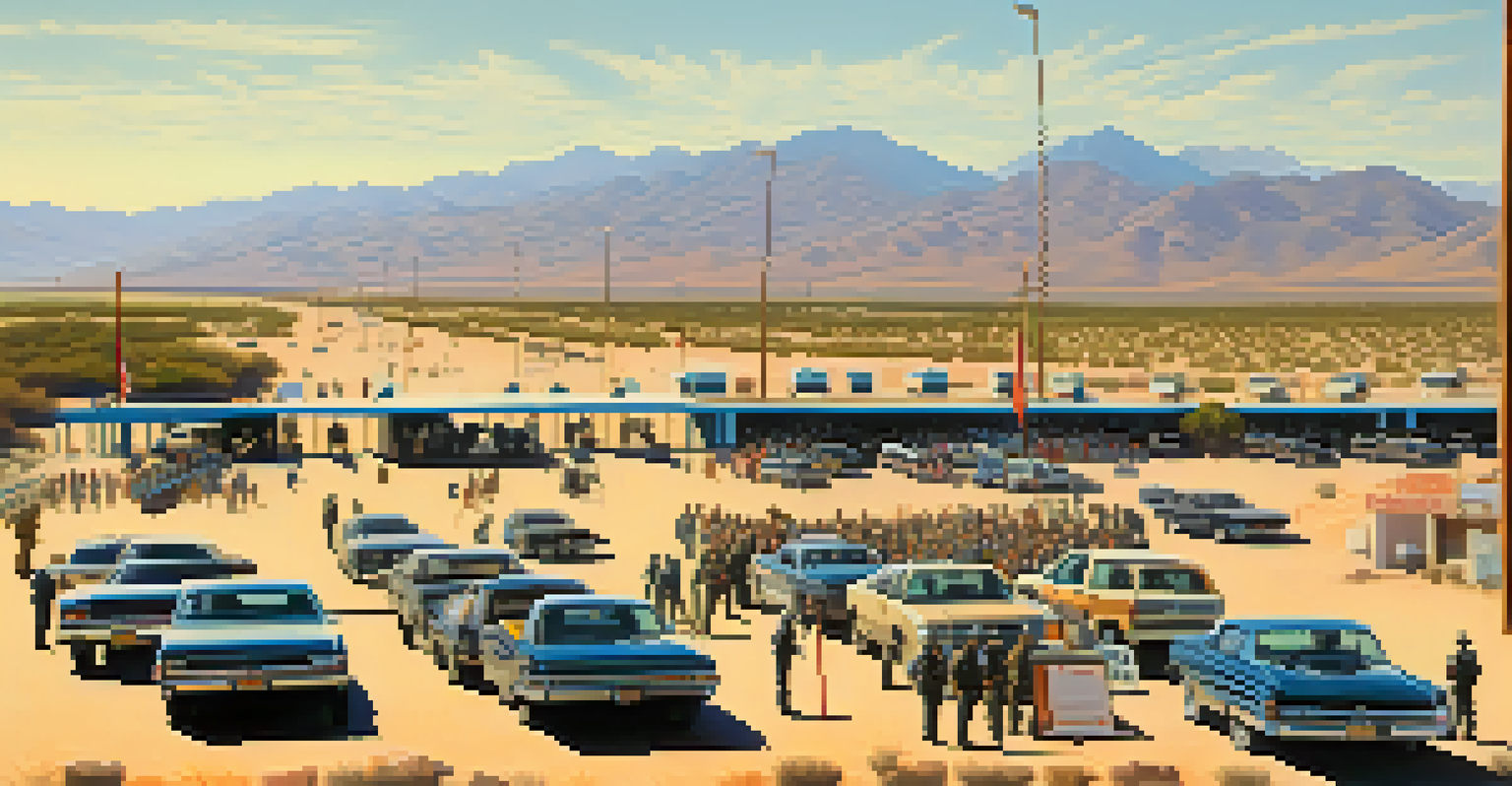Cross-Border Drug Trafficking: Arizona's Strategic Position

Understanding Cross-Border Drug Trafficking
Cross-border drug trafficking refers to the illegal movement of drugs across international borders. This illicit trade has profound implications for public safety, law enforcement, and health systems. Understanding the dynamics of this activity is crucial for creating effective strategies to combat it.
When we think about drug trafficking, we must remember that the issue is not just about drugs, but about people and their communities.
Drug trafficking often involves a complex network of suppliers, distributors, and consumers. In many cases, traffickers exploit vulnerable communities and take advantage of socio-economic disparities. This complexity makes it challenging for authorities to dismantle these operations effectively.
Moreover, the evolution of drug trafficking routes over time reflects changes in law enforcement tactics and market demand. As authorities become more vigilant in one area, traffickers adapt by finding new pathways or methods, perpetuating the cycle of drug-related crime.
Arizona: A Gateway for Drug Traffickers
Arizona's geographical location makes it a critical gateway for drug trafficking into the United States. Situated along the U.S.-Mexico border, the state serves as a prime entry point for various illegal substances. This strategic position presents unique challenges for law enforcement and public health officials.

The state's extensive desert terrain and remote areas provide traffickers with numerous opportunities to smuggle drugs. These natural landscapes can often conceal illegal activities, allowing traffickers to bypass traditional checkpoints. As a result, authorities must develop innovative strategies to monitor and control these vast areas.
Drug Trafficking's Community Impact
Cross-border drug trafficking leads to addiction, crime, and economic instability in Arizona communities.
Additionally, Arizona's proximity to major drug-producing regions in Mexico, such as Sinaloa and Sonora, complicates the situation further. Traffickers can quickly transport drugs across the border, making it imperative for law enforcement to stay one step ahead.
Key Players in Arizona's Drug Trade
Various organizations are involved in Arizona's drug trafficking scene, including powerful drug cartels. These groups often employ sophisticated tactics and technology to evade law enforcement. Understanding their operations is essential for effectively combating drug trafficking.
The drug trade is a complex web of suppliers and consumers that thrives on the vulnerabilities of society.
Local gangs and smaller networks also play a significant role in distributing drugs throughout Arizona. They often act as middlemen, facilitating the movement of drugs from cartels to street-level dealers. This decentralized structure presents challenges for law enforcement, as it requires addressing multiple small-scale operations simultaneously.
Collaborative efforts between federal, state, and local agencies are crucial in tackling these key players. By pooling resources and intelligence, law enforcement can disrupt the supply chain and reduce the prevalence of drugs on Arizona's streets.
The Impact on Communities in Arizona
The consequences of cross-border drug trafficking extend far beyond the drug trade itself; they significantly affect Arizona communities. Increased drug availability contributes to addiction, crime, and violence, straining local resources and affecting public safety. This ripple effect can lead to a cycle of despair in affected neighborhoods.
Moreover, the presence of drug trafficking can undermine the economic stability of communities. Businesses may suffer due to increased crime rates, leading to decreased property values and a lack of investment. Residents may feel unsafe, prompting them to relocate or avoid certain areas altogether.
Arizona as a Trafficking Gateway
Arizona's strategic location along the U.S.-Mexico border makes it a critical entry point for illegal drugs.
It's important to recognize the human cost of drug trafficking, as families and individuals bear the brunt of these challenges. Addressing the root causes of addiction and providing support services is essential to combatting the impact of drug trafficking in Arizona.
Law Enforcement Strategies in Arizona
Law enforcement agencies in Arizona employ a range of strategies to combat cross-border drug trafficking. These include increased patrols along the border, surveillance technology, and intelligence-sharing initiatives. By adopting a multi-faceted approach, authorities aim to disrupt trafficking operations effectively.
Collaborations with federal agencies such as the Drug Enforcement Administration (DEA) and U.S. Customs and Border Protection (CBP) are vital. These partnerships enhance resource allocation and streamline efforts to intercept drugs before they enter communities. This collaborative approach has shown promise in reducing drug trafficking incidence.
Community involvement is also crucial in law enforcement strategies. Encouraging residents to report suspicious activities can help authorities identify trafficking routes and networks. Building trust between law enforcement and communities fosters a proactive environment for addressing drug-related issues.
Public Health Challenges Linked to Drug Trafficking
Cross-border drug trafficking poses significant public health challenges in Arizona. The influx of illicit drugs contributes to rising addiction rates and overdose incidents. This public health crisis calls for a comprehensive response from healthcare providers and policymakers.
Access to addiction treatment and mental health services is crucial for those affected by substance abuse. However, stigma surrounding addiction can hinder individuals from seeking help. Addressing these barriers is essential to ensure that those in need receive the care and support they require.
Collaborative Law Enforcement Efforts
Effective combat against drug trafficking in Arizona requires collaboration between local, state, and federal agencies.
Moreover, public health education campaigns can play a pivotal role in preventing drug misuse. By raising awareness about the dangers of drugs and promoting healthy coping mechanisms, communities can work together to combat the effects of drug trafficking.
Future Directions: Combating Drug Trafficking in Arizona
Looking ahead, Arizona must adapt its strategies to combat the evolving landscape of drug trafficking. As traffickers adopt new methods and technologies, law enforcement agencies need to stay informed and agile. Continuous training and resource allocation will be vital in addressing these challenges.
Community engagement remains a cornerstone of effective drug trafficking prevention. Empowering residents to participate in local initiatives fosters a sense of ownership and responsibility. By working together, communities can create safer environments and support those affected by drugs.

Ultimately, addressing cross-border drug trafficking in Arizona requires a collaborative approach that involves law enforcement, healthcare providers, and communities. By combining resources and expertise, stakeholders can develop sustainable solutions to combat the ongoing crisis.